The Tragedy of the Trees
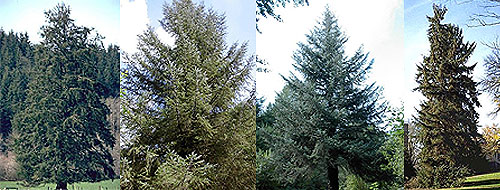
by Robert Allen
|
There is a romantic image that Ireland is a green country, abundant in feisty wildlife among ancient woodland. Sadly, like much else about modern Ireland, it is a myth. Native woods do exist but they are few and far between. And in between are farmed plantations - hundreds of thousands of hectares of them - which are dominated by foreign exotics, one in particular, a north American species known as Sitka Spruce that accounts for nine out of ten trees in the entire country. As for wildlife it too is sparse on the ground, for there is no biodiversity to sustain the fauna that once roamed the land.
|
The problems in Irish forestry are the result of state interference and the formation in 1989 of Coillte Teoranta (Forestry Board), a semi-state body that is actually a private company. Coillte own approximately 1.1 million acres (441,000 hectares - about six percent of the landmass - of which 350,000 are forested). This, despite a ruling in the 1970s that the forests of Ireland belonged to the people of Ireland. Coillte didn't let this bother them and gradually took over what was public land; the people were not asked if they agreed with this initiative. It is sad refrain that has echoed down the centuries.
 Coillte's plantations:
Coillte's plantations:
- have contributed to pollution of water due to acidification, siltation and contamination by phosphate fertilisers
- kill native flora due to the enormous decrease in light reaching the ground
- create a higher risk of insect infestation and disease (e.g. pine weevil outbreaks, which were previously unknown in Ireland, have now taken place)
- require a higher rate of pesticide usage than native broadleaf forests, due to their susceptibility to insect infestation and disease
- are highly susceptible to fire due to the resin content of non-native species. This risk is increased on peatland. contribute to physical damage due to drainage, planting, road-making and felling
- contribute to depopulation and decline of rural villages
- destroy native bio-diversity
http://www.coillte.ie
|
|
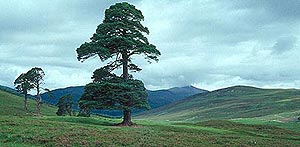 The reforestation of Ireland has been a concern since the early 18th century when the country was finally stripped of its native trees to become a treeless wilderness. The 25 million trees planted by the Anglo-Irish landlords between 1766 and 1806 under the auspices of the Dublin Society now give the impression that Ireland's native trees survived the destruction wrought by human activity. Ireland's native forests were wiped out during a four century orgy, removing from the face of the land trees that had first emerged in the aftermath of the last great ice age 10,000 years ago.
When the last glaciers retreated from Ireland the first trees to rise again were those tolerant of cold conditions - birch, willow and juniper. They were followed by species less tolerant of cold. Broadleaved forests of oak, elm, alder and ash covered the lowlands. Native pines (such as scots pine) rose in the highlands and in the poorer soil of the west. There was so much growth that by the time the first farmers began to cultivate the land between five and six thousand years ago Ireland was covered with broadleaves and evergreens.
The economy of Ireland under the Celts was that of the forests. This great resource was the provider of raw materials, medicine, weapons, tools, charcoal, food (in the form of berries, nuts, fungi, fruit, wild animals, insects and grubs) as well as the basis for spirituality and wisdom. No other country has as many placenames connected to the forest. As many as 40,000 still exist, which, without the woodlands and forests, mean little to anyone who doesn't know the local history. There are many family names associated with native broadleaf trees (McIvor is Son of Yew, McCarthy is Son of Rowan, McColl is Son of Hazel amongst many others). The original Gaelic alphabet for the old Irish language came from the native trees of Ireland - alim (elm), beith (birch), coll (hazel), dair (oak).
The reforestation of Ireland has been a concern since the early 18th century when the country was finally stripped of its native trees to become a treeless wilderness. The 25 million trees planted by the Anglo-Irish landlords between 1766 and 1806 under the auspices of the Dublin Society now give the impression that Ireland's native trees survived the destruction wrought by human activity. Ireland's native forests were wiped out during a four century orgy, removing from the face of the land trees that had first emerged in the aftermath of the last great ice age 10,000 years ago.
When the last glaciers retreated from Ireland the first trees to rise again were those tolerant of cold conditions - birch, willow and juniper. They were followed by species less tolerant of cold. Broadleaved forests of oak, elm, alder and ash covered the lowlands. Native pines (such as scots pine) rose in the highlands and in the poorer soil of the west. There was so much growth that by the time the first farmers began to cultivate the land between five and six thousand years ago Ireland was covered with broadleaves and evergreens.
The economy of Ireland under the Celts was that of the forests. This great resource was the provider of raw materials, medicine, weapons, tools, charcoal, food (in the form of berries, nuts, fungi, fruit, wild animals, insects and grubs) as well as the basis for spirituality and wisdom. No other country has as many placenames connected to the forest. As many as 40,000 still exist, which, without the woodlands and forests, mean little to anyone who doesn't know the local history. There are many family names associated with native broadleaf trees (McIvor is Son of Yew, McCarthy is Son of Rowan, McColl is Son of Hazel amongst many others). The original Gaelic alphabet for the old Irish language came from the native trees of Ireland - alim (elm), beith (birch), coll (hazel), dair (oak).
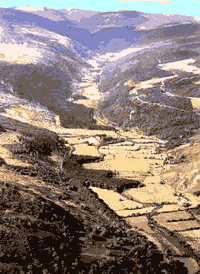 When the Romans conquered most of Britain, Ireland was said to be two-thirds mixed hardwood forest. Despite the emergence of agriculture and the practices of invading tribes, Gerald of Wales, a Norman who came to Ireland as part of Henry II's war mongering entourage in the late 12th century, described Ireland in 1185 as a country of 'many woods and marshes' and 'here and there, some fine plains, but in comparison with the woods they are indeed small'. Sweeney (from the 12th century story Buile Suibhne) refers to the oak, hazel, alder, blackthorn, sloe-bush, watercress, saxifrage, apple, rowan, bramble, ivy, holly, ash, birch and aspen. It wasn't until the 17th century that beech and chestnut were introduced into the Irish woodland landscape.
A few generations later Ireland's rich forests were gone. Ireland's original farmers had started the destruction, clearing woodlands for cultivation, and this practice was continued by peasant subsistence farmers. The depletion continued as people used wood as a source of fuel and for building material. Then the colonising English started to fell the woodlands to deny the Irish hiding places in the early battles for the land. In the 15th, 16th and 17th centuries they cut the forests down to provide timber for the British ships which would plunder and exploit other lands and other people.
Since then the nature of Irish farming and Irish politics wrought more damage. Ray Monahan, from Balliseedy, County Kerry, noted the dilemma that faced the farmers: 'They were subsistence farmers, so every tree was preventing their cow or sheep from eating grass. The English, when their colonisation became complete after 1604 when they defeated the last of the Irish High Kings, cut down many of the trees because the Irish had used them as refuges in the wars. But they realized they'd cut too much, so they began replanting. The Irish peasant was told in effect, we're replanting oak that takes 200 years to grow. You'll never get this land. And most Irish people passed being subsistence farmers only 50 or 60 years ago.'
Ireland, however, is still a forest country. The conditions are perfect for the growth of trees. Sadly this has led to the plantation of sitka spruce, which grows three times faster in Ireland than elsewhere in Europe. Timber products are the largest EU import after oil. Ireland is only nine percent afforested, whereas the European average is 31 percent [See also Global Resources].
When the Romans conquered most of Britain, Ireland was said to be two-thirds mixed hardwood forest. Despite the emergence of agriculture and the practices of invading tribes, Gerald of Wales, a Norman who came to Ireland as part of Henry II's war mongering entourage in the late 12th century, described Ireland in 1185 as a country of 'many woods and marshes' and 'here and there, some fine plains, but in comparison with the woods they are indeed small'. Sweeney (from the 12th century story Buile Suibhne) refers to the oak, hazel, alder, blackthorn, sloe-bush, watercress, saxifrage, apple, rowan, bramble, ivy, holly, ash, birch and aspen. It wasn't until the 17th century that beech and chestnut were introduced into the Irish woodland landscape.
A few generations later Ireland's rich forests were gone. Ireland's original farmers had started the destruction, clearing woodlands for cultivation, and this practice was continued by peasant subsistence farmers. The depletion continued as people used wood as a source of fuel and for building material. Then the colonising English started to fell the woodlands to deny the Irish hiding places in the early battles for the land. In the 15th, 16th and 17th centuries they cut the forests down to provide timber for the British ships which would plunder and exploit other lands and other people.
Since then the nature of Irish farming and Irish politics wrought more damage. Ray Monahan, from Balliseedy, County Kerry, noted the dilemma that faced the farmers: 'They were subsistence farmers, so every tree was preventing their cow or sheep from eating grass. The English, when their colonisation became complete after 1604 when they defeated the last of the Irish High Kings, cut down many of the trees because the Irish had used them as refuges in the wars. But they realized they'd cut too much, so they began replanting. The Irish peasant was told in effect, we're replanting oak that takes 200 years to grow. You'll never get this land. And most Irish people passed being subsistence farmers only 50 or 60 years ago.'
Ireland, however, is still a forest country. The conditions are perfect for the growth of trees. Sadly this has led to the plantation of sitka spruce, which grows three times faster in Ireland than elsewhere in Europe. Timber products are the largest EU import after oil. Ireland is only nine percent afforested, whereas the European average is 31 percent [See also Global Resources].
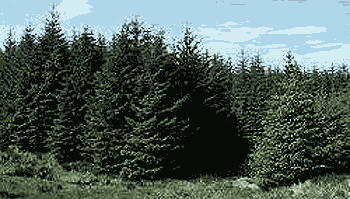 Teagasc (agricultural advisory department) announced in the late 1990s that at least 1.5 million hectares (22 percent of the landmass) was marginal for agriculture, and envisaged increasing forestry acreage to 1.2 million hectares, double the 600,000 hectares at 2004 figures, of which 441,000 hectares are controlled by Coillte. Of the Coillte total only 12,000 hectares are broadleaved trees. In September 2004 a report commissioned by the state announced that 'the policy aim was to achieve a productive forest area of 1.189 million hectares'.
Cormac Ó Snodaigh, of the Indigenous Woodland Trust - which set out in 1997 to collect seeds, acquire land and reforest land, said: 'There seems to be an awareness that we need to reforest this island with native and natural broadleaf trees on an island wide scale to ensure our future survival.'
It is a notion that the state, which has long regarded forestry as a resource, has no interest in. Ó Snodaigh: 'Forestry in this country is totally commercial. This is not good since there are too many losers in this scenario and the myriad of benefits associated with good woodland, forestry management are not being realised. Woodlands and the biodiversity within them are essential to environmental healing. We want to see the reforestation of Ireland.' [see also Community forest groups demands]
Coillte draws millions in EU grants while companies and individuals may receive forestry grants of between €2,730 and €6,730 per hectare, which cover all the costs of drainage, planting and fencing. See teagasc and coillte. Coillte and other forestry investment companies are drawing down not only the planting grants, but the annual grant (between €170 and €474), intended for the small growers, as well. This has led to controversy. In 2002 the EU demanded that Coillte repay €30m in funding that should have gone to small growers.
Teagasc (agricultural advisory department) announced in the late 1990s that at least 1.5 million hectares (22 percent of the landmass) was marginal for agriculture, and envisaged increasing forestry acreage to 1.2 million hectares, double the 600,000 hectares at 2004 figures, of which 441,000 hectares are controlled by Coillte. Of the Coillte total only 12,000 hectares are broadleaved trees. In September 2004 a report commissioned by the state announced that 'the policy aim was to achieve a productive forest area of 1.189 million hectares'.
Cormac Ó Snodaigh, of the Indigenous Woodland Trust - which set out in 1997 to collect seeds, acquire land and reforest land, said: 'There seems to be an awareness that we need to reforest this island with native and natural broadleaf trees on an island wide scale to ensure our future survival.'
It is a notion that the state, which has long regarded forestry as a resource, has no interest in. Ó Snodaigh: 'Forestry in this country is totally commercial. This is not good since there are too many losers in this scenario and the myriad of benefits associated with good woodland, forestry management are not being realised. Woodlands and the biodiversity within them are essential to environmental healing. We want to see the reforestation of Ireland.' [see also Community forest groups demands]
Coillte draws millions in EU grants while companies and individuals may receive forestry grants of between €2,730 and €6,730 per hectare, which cover all the costs of drainage, planting and fencing. See teagasc and coillte. Coillte and other forestry investment companies are drawing down not only the planting grants, but the annual grant (between €170 and €474), intended for the small growers, as well. This has led to controversy. In 2002 the EU demanded that Coillte repay €30m in funding that should have gone to small growers.
Woodland League Petition:
The Woodland League in Ireland has started a petition, online at http://www.petitiononline.com/rfpii. This petition will be directed at Coillte (the main culprit), Forest Stewardship Council International, The Soil Association (the people who certify Coillte) and Irish Forestry Certification Initiative (Forest Stewardship Council National Initiative for Ireland). Despite all this, Coillte have managed to obtain Forest Stewardship Council certification, to a national standard that is far weaker to the Forest Stewardship Council principles.
http://www.petitiononline.com/rfpii
The petition can also be signed by sending an email to ciaran_hughes@yahoo.co.uk, with name, address, organisation (if applicable) and any comment that is wished.
|
|
The Woodland League also share the Indigenous Woodland Trust's ideals and politics. In their information material they note: 'Coillte's past and present standards of operation are far below the international Forest Stewardship Council standards for sustainable plantations and natural forests. Certification of Coillte may jeopardise the reputation and integrity of the Forest Stewardship Council Eco-label in Ireland and abroad. It may also undermine our efforts to encourage Irish consumers to demand Forest Stewardship Council certified local wood products and Forest Stewardship Council certified hardwood imports. We need to be in a position to convince and guarantee consumers that Forest Stewardship Council does represent true sustainability - economically, socially and environmentally. If Coillte is certified at current standards, changing consumer patterns will become an onerous task.
'There has been no commitment by Coillte for a holistic review of company policy with regard to broadening their primary mandate, which is economic return. Coillte continues to have a policy of clearfelling and a policy of minimum broadleaf planting on public land and on farms in the Coillte Farm Partnership Scheme. Coillte appears to have an unofficial policy of creeping privatisation. The sale and long-term leasing of publicly owned forests without local or national public consultation continues to increase. Coillte has failed to address communities' concerns and has failed to implement measures to demonstrate transparency and accountability in all transactions.
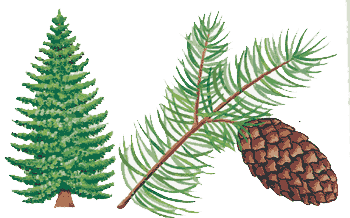 'Our forests continue to be ear-marked for the development of private recreational facilities, high cost luxury tourist and residential accommodation, land-fill sites, power stations, wind-farms, phone-masts, commercial and industrial sites, etc. Local communities are not consulted in advance regarding proposed change of ownership and use. Communities, fearful that their local forest may be privatised without notice, must constantly monitor planning applications to ensure that their forests remain in public ownership for long-term public use.'
Coillte, the Woodland League claim, are in breach of the UN Convention on Biological Diversity, the Helsinki Agreement on Forestry, the Rio Agreement on Biodiversity, the Ministerial Conferences on the Protection of Forests in Europe at Strasbourg and Lisbon. The Helsinki Conference definition for sustainable forest management states that 'the stewardship and use of forest and forest land in a way, and at a rate, that maintains their biodiversity, productivity, regeneration capacity, vitality and their potential to fulfil, now and in the future, relevant ecological, economical and social functions, at local, national and global levels and that does not cause damage to other ecosystems'.
This, the Woodland League note, is not a description of Coillte forestry. But there are other worrying issues such as the use of pesticides, which the Irish Forestry Certification Initiative (the body that was set up in 1999 to issue Forest Stewardship Council certification to Coillte), allows. People Against Pesticides, a Galway group, fought hard to prevent pesticide usage in the IFCI standard, so hard that their representative on the Irish Forestry Certification Initiative was removed. Despite clear evidence of the dangers to human health of pesticides, the Irish state has given Coillte a free reign.
In despair the Woodland League have stepped up their campaign, to involve Forest Stewardship Council International [see What Is The Forest Stewardship Council?], other international groups which work on forestry and biodiversity and those who understand why Coillte need to be stopped.
'Our forests continue to be ear-marked for the development of private recreational facilities, high cost luxury tourist and residential accommodation, land-fill sites, power stations, wind-farms, phone-masts, commercial and industrial sites, etc. Local communities are not consulted in advance regarding proposed change of ownership and use. Communities, fearful that their local forest may be privatised without notice, must constantly monitor planning applications to ensure that their forests remain in public ownership for long-term public use.'
Coillte, the Woodland League claim, are in breach of the UN Convention on Biological Diversity, the Helsinki Agreement on Forestry, the Rio Agreement on Biodiversity, the Ministerial Conferences on the Protection of Forests in Europe at Strasbourg and Lisbon. The Helsinki Conference definition for sustainable forest management states that 'the stewardship and use of forest and forest land in a way, and at a rate, that maintains their biodiversity, productivity, regeneration capacity, vitality and their potential to fulfil, now and in the future, relevant ecological, economical and social functions, at local, national and global levels and that does not cause damage to other ecosystems'.
This, the Woodland League note, is not a description of Coillte forestry. But there are other worrying issues such as the use of pesticides, which the Irish Forestry Certification Initiative (the body that was set up in 1999 to issue Forest Stewardship Council certification to Coillte), allows. People Against Pesticides, a Galway group, fought hard to prevent pesticide usage in the IFCI standard, so hard that their representative on the Irish Forestry Certification Initiative was removed. Despite clear evidence of the dangers to human health of pesticides, the Irish state has given Coillte a free reign.
In despair the Woodland League have stepped up their campaign, to involve Forest Stewardship Council International [see What Is The Forest Stewardship Council?], other international groups which work on forestry and biodiversity and those who understand why Coillte need to be stopped.
-
–
Robert Allen
Photographs courtesy of Isle of Lismore and Savannah. Thanks to Éanna Dowling, Ciarán Hughes, Ray Monahan and Cormac Ó Snodaigh. Statistics from Peter Bacon and Associates (A Review and Appraisal of Ireland’s Forestry Development Strategy), Central Statistics Office, Coillte, Department of Agriculture, Food and Forestry, Forest Stewardship Council, Teagasc and United Nations Food and Agricultural Organisaton. Part of this feature was drawn from material written by (the late) Dr. Ann Behan and Jacinta French.
-
-
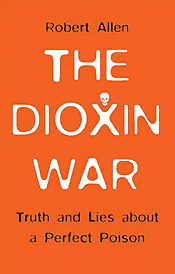 Robert Allen is the author of Dioxin War: Truth & Lies About A Perfect Poison, Pluto Press, London/Ann Arbor/Dublin and University of Michigan, US, published in July 2004. Amazon.co.uk, Amazon.com.
Book Description
This is a book about Dioxin, one of the most poisonous chemicals known to humanity. It was the toxic component of Agent Orange, used by the US military to defoliate huge tracts of Vietnam during the war in the 60s and 70s.
It can be found in pesticides, plastics, solvents, detergents and cosmetics. Dioxin has been revealed as a human carcinogen, and has been associated with heart disease, liver damage, hormonal disruption, reproductive disorders, developmental destruction and neurological impairment.
The Dioxin War is the story of the people who fought to reveal the truth about dioxin. Huge multinationals Dow and Monsanto both manufactured Agent Orange. Robert Allen reveals the attempts by the chemical industry, in collusion with regulatory and health authorities, to cover up the true impact of dioxin on human health. He tells the remarkable story of how a small, dedicated group of people managed to bring the truth about dioxin into the public domain and into the courts - and win.
Robert Allen is the author of Dioxin War: Truth & Lies About A Perfect Poison, Pluto Press, London/Ann Arbor/Dublin and University of Michigan, US, published in July 2004. Amazon.co.uk, Amazon.com.
Book Description
This is a book about Dioxin, one of the most poisonous chemicals known to humanity. It was the toxic component of Agent Orange, used by the US military to defoliate huge tracts of Vietnam during the war in the 60s and 70s.
It can be found in pesticides, plastics, solvents, detergents and cosmetics. Dioxin has been revealed as a human carcinogen, and has been associated with heart disease, liver damage, hormonal disruption, reproductive disorders, developmental destruction and neurological impairment.
The Dioxin War is the story of the people who fought to reveal the truth about dioxin. Huge multinationals Dow and Monsanto both manufactured Agent Orange. Robert Allen reveals the attempts by the chemical industry, in collusion with regulatory and health authorities, to cover up the true impact of dioxin on human health. He tells the remarkable story of how a small, dedicated group of people managed to bring the truth about dioxin into the public domain and into the courts - and win.
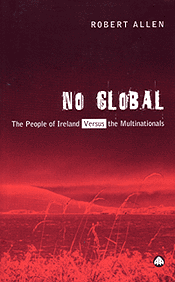 Robert Allen is the author of No Global: The People of Ireland versus the Multinationals, Pluto Press, London/Ann Arbor/Dublin, published in April 2004. Amazon.co.uk, Amazon.com.
Book Description
Ireland's economy has seen phenomenal growth since the 1990s, as a result of an earlier decision by the state to chase foreign investment, largely from US corporates. As a result, manufacturers of raw chemicals, pharmaceuticals and highly dangerous substances came to Ireland, where they could make toxic products free from the strict controls imposed by other nations.
Robert Allen's book reveals the consequences to human health and the environment of the Irish state's love affair with the multinational chemical industry. The cost to Irish society was a series of ecological and social outrages, starting in the 1970s and continuing into the 2000s.
No Global is a lesson for countries who seek to encourage multinationals at the expense of the health their population and the delicate nature of their ecosystems. It is also a heart-warming record of the successful campaigns fought by local people to protect themselves and their environment from polluting industry
Robert Allen is the author of No Global: The People of Ireland versus the Multinationals, Pluto Press, London/Ann Arbor/Dublin, published in April 2004. Amazon.co.uk, Amazon.com.
Book Description
Ireland's economy has seen phenomenal growth since the 1990s, as a result of an earlier decision by the state to chase foreign investment, largely from US corporates. As a result, manufacturers of raw chemicals, pharmaceuticals and highly dangerous substances came to Ireland, where they could make toxic products free from the strict controls imposed by other nations.
Robert Allen's book reveals the consequences to human health and the environment of the Irish state's love affair with the multinational chemical industry. The cost to Irish society was a series of ecological and social outrages, starting in the 1970s and continuing into the 2000s.
No Global is a lesson for countries who seek to encourage multinationals at the expense of the health their population and the delicate nature of their ecosystems. It is also a heart-warming record of the successful campaigns fought by local people to protect themselves and their environment from polluting industry
|
|

 The reforestation of Ireland has been a concern since the early 18th century when the country was finally stripped of its native trees to become a treeless wilderness. The 25 million trees planted by the Anglo-Irish landlords between 1766 and 1806 under the auspices of the Dublin Society now give the impression that Ireland's native trees survived the destruction wrought by human activity. Ireland's native forests were wiped out during a four century orgy, removing from the face of the land trees that had first emerged in the aftermath of the last great ice age 10,000 years ago.
When the last glaciers retreated from Ireland the first trees to rise again were those tolerant of cold conditions - birch, willow and juniper. They were followed by species less tolerant of cold. Broadleaved forests of oak, elm, alder and ash covered the lowlands. Native pines (such as scots pine) rose in the highlands and in the poorer soil of the west. There was so much growth that by the time the first farmers began to cultivate the land between five and six thousand years ago Ireland was covered with broadleaves and evergreens.
The economy of Ireland under the Celts was that of the forests. This great resource was the provider of raw materials, medicine, weapons, tools, charcoal, food (in the form of berries, nuts, fungi, fruit, wild animals, insects and grubs) as well as the basis for spirituality and wisdom. No other country has as many placenames connected to the forest. As many as 40,000 still exist, which, without the woodlands and forests, mean little to anyone who doesn't know the local history. There are many family names associated with native broadleaf trees (McIvor is Son of Yew, McCarthy is Son of Rowan, McColl is Son of Hazel amongst many others). The original Gaelic alphabet for the old Irish language came from the native trees of Ireland - alim (elm), beith (birch), coll (hazel), dair (oak).
The reforestation of Ireland has been a concern since the early 18th century when the country was finally stripped of its native trees to become a treeless wilderness. The 25 million trees planted by the Anglo-Irish landlords between 1766 and 1806 under the auspices of the Dublin Society now give the impression that Ireland's native trees survived the destruction wrought by human activity. Ireland's native forests were wiped out during a four century orgy, removing from the face of the land trees that had first emerged in the aftermath of the last great ice age 10,000 years ago.
When the last glaciers retreated from Ireland the first trees to rise again were those tolerant of cold conditions - birch, willow and juniper. They were followed by species less tolerant of cold. Broadleaved forests of oak, elm, alder and ash covered the lowlands. Native pines (such as scots pine) rose in the highlands and in the poorer soil of the west. There was so much growth that by the time the first farmers began to cultivate the land between five and six thousand years ago Ireland was covered with broadleaves and evergreens.
The economy of Ireland under the Celts was that of the forests. This great resource was the provider of raw materials, medicine, weapons, tools, charcoal, food (in the form of berries, nuts, fungi, fruit, wild animals, insects and grubs) as well as the basis for spirituality and wisdom. No other country has as many placenames connected to the forest. As many as 40,000 still exist, which, without the woodlands and forests, mean little to anyone who doesn't know the local history. There are many family names associated with native broadleaf trees (McIvor is Son of Yew, McCarthy is Son of Rowan, McColl is Son of Hazel amongst many others). The original Gaelic alphabet for the old Irish language came from the native trees of Ireland - alim (elm), beith (birch), coll (hazel), dair (oak).
 When the Romans conquered most of Britain, Ireland was said to be two-thirds mixed hardwood forest. Despite the emergence of agriculture and the practices of invading tribes, Gerald of Wales, a Norman who came to Ireland as part of Henry II's war mongering entourage in the late 12th century, described Ireland in 1185 as a country of 'many woods and marshes' and 'here and there, some fine plains, but in comparison with the woods they are indeed small'. Sweeney (from the 12th century story Buile Suibhne) refers to the oak, hazel, alder, blackthorn, sloe-bush, watercress, saxifrage, apple, rowan, bramble, ivy, holly, ash, birch and aspen. It wasn't until the 17th century that beech and chestnut were introduced into the Irish woodland landscape.
A few generations later Ireland's rich forests were gone. Ireland's original farmers had started the destruction, clearing woodlands for cultivation, and this practice was continued by peasant subsistence farmers. The depletion continued as people used wood as a source of fuel and for building material. Then the colonising English started to fell the woodlands to deny the Irish hiding places in the early battles for the land. In the 15th, 16th and 17th centuries they cut the forests down to provide timber for the British ships which would plunder and exploit other lands and other people.
Since then the nature of Irish farming and Irish politics wrought more damage. Ray Monahan, from Balliseedy, County Kerry, noted the dilemma that faced the farmers: 'They were subsistence farmers, so every tree was preventing their cow or sheep from eating grass. The English, when their colonisation became complete after 1604 when they defeated the last of the Irish High Kings, cut down many of the trees because the Irish had used them as refuges in the wars. But they realized they'd cut too much, so they began replanting. The Irish peasant was told in effect, we're replanting oak that takes 200 years to grow. You'll never get this land. And most Irish people passed being subsistence farmers only 50 or 60 years ago.'
Ireland, however, is still a forest country. The conditions are perfect for the growth of trees. Sadly this has led to the plantation of sitka spruce, which grows three times faster in Ireland than elsewhere in Europe. Timber products are the largest EU import after oil. Ireland is only nine percent afforested, whereas the European average is 31 percent [See also Global Resources].
When the Romans conquered most of Britain, Ireland was said to be two-thirds mixed hardwood forest. Despite the emergence of agriculture and the practices of invading tribes, Gerald of Wales, a Norman who came to Ireland as part of Henry II's war mongering entourage in the late 12th century, described Ireland in 1185 as a country of 'many woods and marshes' and 'here and there, some fine plains, but in comparison with the woods they are indeed small'. Sweeney (from the 12th century story Buile Suibhne) refers to the oak, hazel, alder, blackthorn, sloe-bush, watercress, saxifrage, apple, rowan, bramble, ivy, holly, ash, birch and aspen. It wasn't until the 17th century that beech and chestnut were introduced into the Irish woodland landscape.
A few generations later Ireland's rich forests were gone. Ireland's original farmers had started the destruction, clearing woodlands for cultivation, and this practice was continued by peasant subsistence farmers. The depletion continued as people used wood as a source of fuel and for building material. Then the colonising English started to fell the woodlands to deny the Irish hiding places in the early battles for the land. In the 15th, 16th and 17th centuries they cut the forests down to provide timber for the British ships which would plunder and exploit other lands and other people.
Since then the nature of Irish farming and Irish politics wrought more damage. Ray Monahan, from Balliseedy, County Kerry, noted the dilemma that faced the farmers: 'They were subsistence farmers, so every tree was preventing their cow or sheep from eating grass. The English, when their colonisation became complete after 1604 when they defeated the last of the Irish High Kings, cut down many of the trees because the Irish had used them as refuges in the wars. But they realized they'd cut too much, so they began replanting. The Irish peasant was told in effect, we're replanting oak that takes 200 years to grow. You'll never get this land. And most Irish people passed being subsistence farmers only 50 or 60 years ago.'
Ireland, however, is still a forest country. The conditions are perfect for the growth of trees. Sadly this has led to the plantation of sitka spruce, which grows three times faster in Ireland than elsewhere in Europe. Timber products are the largest EU import after oil. Ireland is only nine percent afforested, whereas the European average is 31 percent [See also Global Resources].
 Teagasc (agricultural advisory department) announced in the late 1990s that at least 1.5 million hectares (22 percent of the landmass) was marginal for agriculture, and envisaged increasing forestry acreage to 1.2 million hectares, double the 600,000 hectares at 2004 figures, of which 441,000 hectares are controlled by Coillte. Of the Coillte total only 12,000 hectares are broadleaved trees. In September 2004 a report commissioned by the state announced that 'the policy aim was to achieve a productive forest area of 1.189 million hectares'.
Cormac Ó Snodaigh, of the Indigenous Woodland Trust - which set out in 1997 to collect seeds, acquire land and reforest land, said: 'There seems to be an awareness that we need to reforest this island with native and natural broadleaf trees on an island wide scale to ensure our future survival.'
It is a notion that the state, which has long regarded forestry as a resource, has no interest in. Ó Snodaigh: 'Forestry in this country is totally commercial. This is not good since there are too many losers in this scenario and the myriad of benefits associated with good woodland, forestry management are not being realised. Woodlands and the biodiversity within them are essential to environmental healing. We want to see the reforestation of Ireland.' [see also Community forest groups demands]
Coillte draws millions in EU grants while companies and individuals may receive forestry grants of between €2,730 and €6,730 per hectare, which cover all the costs of drainage, planting and fencing. See teagasc and coillte. Coillte and other forestry investment companies are drawing down not only the planting grants, but the annual grant (between €170 and €474), intended for the small growers, as well. This has led to controversy. In 2002 the EU demanded that Coillte repay €30m in funding that should have gone to small growers.
Teagasc (agricultural advisory department) announced in the late 1990s that at least 1.5 million hectares (22 percent of the landmass) was marginal for agriculture, and envisaged increasing forestry acreage to 1.2 million hectares, double the 600,000 hectares at 2004 figures, of which 441,000 hectares are controlled by Coillte. Of the Coillte total only 12,000 hectares are broadleaved trees. In September 2004 a report commissioned by the state announced that 'the policy aim was to achieve a productive forest area of 1.189 million hectares'.
Cormac Ó Snodaigh, of the Indigenous Woodland Trust - which set out in 1997 to collect seeds, acquire land and reforest land, said: 'There seems to be an awareness that we need to reforest this island with native and natural broadleaf trees on an island wide scale to ensure our future survival.'
It is a notion that the state, which has long regarded forestry as a resource, has no interest in. Ó Snodaigh: 'Forestry in this country is totally commercial. This is not good since there are too many losers in this scenario and the myriad of benefits associated with good woodland, forestry management are not being realised. Woodlands and the biodiversity within them are essential to environmental healing. We want to see the reforestation of Ireland.' [see also Community forest groups demands]
Coillte draws millions in EU grants while companies and individuals may receive forestry grants of between €2,730 and €6,730 per hectare, which cover all the costs of drainage, planting and fencing. See teagasc and coillte. Coillte and other forestry investment companies are drawing down not only the planting grants, but the annual grant (between €170 and €474), intended for the small growers, as well. This has led to controversy. In 2002 the EU demanded that Coillte repay €30m in funding that should have gone to small growers.



 Robert Allen is the author of Dioxin War: Truth & Lies About A Perfect Poison, Pluto Press, London/Ann Arbor/Dublin and
Robert Allen is the author of Dioxin War: Truth & Lies About A Perfect Poison, Pluto Press, London/Ann Arbor/Dublin and  Robert Allen is the author of No Global: The People of Ireland versus the Multinationals, Pluto Press, London/Ann Arbor/Dublin, published in April 2004.
Robert Allen is the author of No Global: The People of Ireland versus the Multinationals, Pluto Press, London/Ann Arbor/Dublin, published in April 2004.